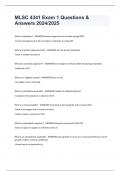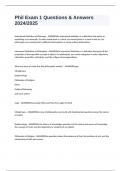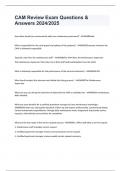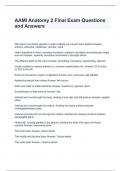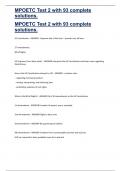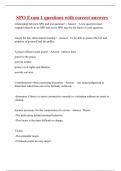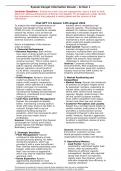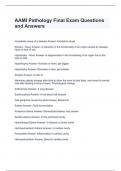Biologie
Thema 1: functionele morfologie van de cel
morfologie = leer van de vorm van cellen
cytologie = leer van de cel
1. Cellen in relatie met andere organisatieniveaus
de biosfeer is georganiseerd in verschillende ecosystemen waarin populaties van allerlei soorten
organismen voorkomen
mens --> 1014 cellen (rode bloedcellen, longcellen, neuronen, …)
DNA = DesoxyriboNucleïneZuur
DeoxyriboNucleïcAcid
cel = kleinste eenheid binnen een levend wezen, die alle genetische informatie van een
organisme bevat
levende organismen: planten, dieren, schimmels, gisten, bacteriën en protisten
organisme:
atomen < moleculen < celorganellen < cellen <
weefsel < organen < orgaanstelsel < organismen <
populatie < levensgem. < ecosysteem < bioom <
biosfeer
2. Observeren van cellen
Robert Hooke (17de eeuw) --> eerste microscoop
cellen met blote oog zien
dooier van struisvogelei (grootste)
neuronen blauwe vinvis (langste)
grootste cel menselijk lichaam = eicel
kleinste cel menselijk lichaam = zaadcel
3. Submicroscopische studie van het celoppervlak
3.1 celwand (enkel bij plantaarige cellen)
planten --> celwand met cellulose
funghi --> celwand met chitine
bacteriën --> celwand met mucopeptide
, functie:
- celwand verleent stevigheid aan de cel
- celwand fungeert als een beschermende laag tegen afbraak of tegen ongunstige
milieuomstandigheden
3.2 celmembraan
= plasmalemma
vormt barrière tussen celinhoud (intracellulair) en het externe milieu (extracellulair) van cel
belangrijke rol bij het goed functioneren van de cel door bepaalde stoffen al dan niet door te
laten, zowel naar binnen als naar buiten
bouw:
- ca. 10 nm dik
- dubbele fosfolipidenlaag
fosfaatkop is hydrofiel (= waterminnend)
polair polair
vetzuurstaarten zijn hydrofoob (= waterafstotend)
apolair <-> polair
Omdat het cytoplasma veel water bevat en omdat cellen in organismen
zich bevinden in een waterig milieu, gaan de fosfolipiden dubbellagen
vormen, waarbij de hydrofobe staarten naar elkaar gekeerd.
1. tussen fosfolipiden: cholesterol
- cholesterolmoleculen maken het membraan minder vloeibaar, minder
vervormbaar en minder permeabel (doorlaatbaar)
- plantencel heeft geen cholesterolmoleculen nodig
(stevig genoeg door celwand)
2. tussen de fosfolipiden zijn er perifere proteïnen
- aan de rand: buitenkant/binnenkant celmembraan
- drijven op de dubbellaag
- vormen o.a. receptoren
- functie: herkennen van stoffen (moleculaire signalen) buiten de cel
Thema 1: functionele morfologie van de cel
morfologie = leer van de vorm van cellen
cytologie = leer van de cel
1. Cellen in relatie met andere organisatieniveaus
de biosfeer is georganiseerd in verschillende ecosystemen waarin populaties van allerlei soorten
organismen voorkomen
mens --> 1014 cellen (rode bloedcellen, longcellen, neuronen, …)
DNA = DesoxyriboNucleïneZuur
DeoxyriboNucleïcAcid
cel = kleinste eenheid binnen een levend wezen, die alle genetische informatie van een
organisme bevat
levende organismen: planten, dieren, schimmels, gisten, bacteriën en protisten
organisme:
atomen < moleculen < celorganellen < cellen <
weefsel < organen < orgaanstelsel < organismen <
populatie < levensgem. < ecosysteem < bioom <
biosfeer
2. Observeren van cellen
Robert Hooke (17de eeuw) --> eerste microscoop
cellen met blote oog zien
dooier van struisvogelei (grootste)
neuronen blauwe vinvis (langste)
grootste cel menselijk lichaam = eicel
kleinste cel menselijk lichaam = zaadcel
3. Submicroscopische studie van het celoppervlak
3.1 celwand (enkel bij plantaarige cellen)
planten --> celwand met cellulose
funghi --> celwand met chitine
bacteriën --> celwand met mucopeptide
, functie:
- celwand verleent stevigheid aan de cel
- celwand fungeert als een beschermende laag tegen afbraak of tegen ongunstige
milieuomstandigheden
3.2 celmembraan
= plasmalemma
vormt barrière tussen celinhoud (intracellulair) en het externe milieu (extracellulair) van cel
belangrijke rol bij het goed functioneren van de cel door bepaalde stoffen al dan niet door te
laten, zowel naar binnen als naar buiten
bouw:
- ca. 10 nm dik
- dubbele fosfolipidenlaag
fosfaatkop is hydrofiel (= waterminnend)
polair polair
vetzuurstaarten zijn hydrofoob (= waterafstotend)
apolair <-> polair
Omdat het cytoplasma veel water bevat en omdat cellen in organismen
zich bevinden in een waterig milieu, gaan de fosfolipiden dubbellagen
vormen, waarbij de hydrofobe staarten naar elkaar gekeerd.
1. tussen fosfolipiden: cholesterol
- cholesterolmoleculen maken het membraan minder vloeibaar, minder
vervormbaar en minder permeabel (doorlaatbaar)
- plantencel heeft geen cholesterolmoleculen nodig
(stevig genoeg door celwand)
2. tussen de fosfolipiden zijn er perifere proteïnen
- aan de rand: buitenkant/binnenkant celmembraan
- drijven op de dubbellaag
- vormen o.a. receptoren
- functie: herkennen van stoffen (moleculaire signalen) buiten de cel


